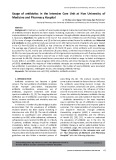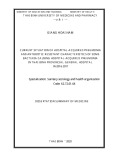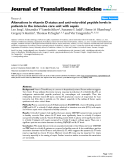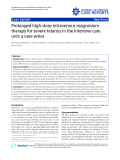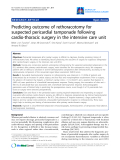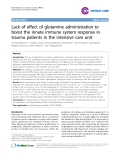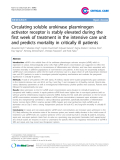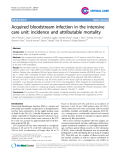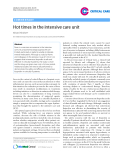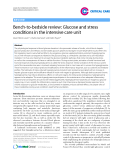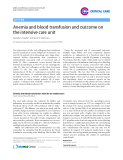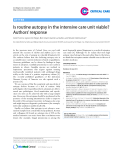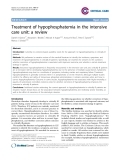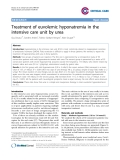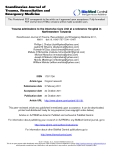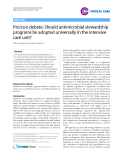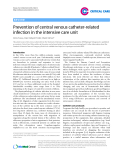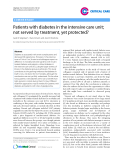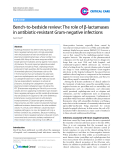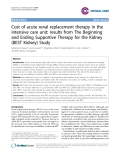
33
Journal of Medicine and Pharmacy, Volume 11, No.07/2021
Usage of antibiotics in the Intensive Care Unit at Hue University of
Medicine and Pharmacy Hospital
Le Thi Kieu Loan, Nguyen Van Dung, Ngo Thi Kim Cuc*
Faculty of Pharmacy, Hue University of Medicine and Pharmacy, Hue University, Vietnam
Abstract
Background: In Vietnam, a number of recent epidemiological studies demonstrated that the prevalence
of antibiotic-resistant bacteria has been rapidly increasing, especially in intensive care units (ICUs). The
implementation of comprehensive and long-term measures through antibiotic stewardship programs (AMS)
is necessary. Objectives: For patients in the ICU of Hue University of Medicine and Pharmacy Hospital:
(1) To survey of usage of antibiotics, and (2) to find out patient-related factors for antibiotic use. Materials
and methods: A cross-sectional study was carried out on 102 medical records of patients who were treated
in the ICU from 01/2019 to 10/2020, at Hue University of Medicine and Pharmacy Hospital. Results:
The average age of patients was quite high at 70.71±19.70 years. Initial antibiotic with monotherapy
accounted for 41.2%, mainly was ceftriaxone (28 prescribed), combined two antibiotics accounted for
49.0%, the most popular was the combination of third generation cephalosprins with fluoroquinolones.
Most of participants prescribed a total of two or three types of antibiotics in their medical records
(accounted for 68.6%). Patient-related factors associated with antibiotics usage included: antibiogram
results (OR=4.7, p=0.039), sepsis diagnosis (OR=12.0, p=0.04), and initial therapeutic change (OR=14.5,
p=0.002). Conclusion: The majority of initial antibiotic therapies are monotherapy and a combination of
two antibiotics in accordance with the recommendation. The number of used antibiotics were associated
with the sepsis diagnosis, antibiogram results, and changing antibiotic therapy.
Keywords: The intensive care unit (ICU), antibiotics, antibiotic-resistant.
Corresponding author: Ngo Thi Kim Cuc; email: ntkcuc@huemed-univ.edu.vn
Received: 3/9/2021; Accepted: 13/10/2021; Published: 30/12/2021
DOI: 10.34071/jmp.2021.7.5
1. INTRODUCTION
Antibiotic resistance has become a global
concern. The main problems of antibiotic resistance
include improper prescription, inappropriate
antibiotic combinations, unnecessary use of
antibiotics, long-term treatment with broad-
spectrum antibiotics [1], [2]. The inappropriate and
ineffective use of antibiotics could lead to therapy
failure, increase morbidity and mortality rates and
healthcare costs [2].
In Vietnam, a number of epidemiological studies
demonstrated that the prevalence of antibiotic-
resistant bacteria has been rapidly increasing in
intensive care units (ICU) [3]. The rate of antibiotic
resistance to ciprofloxacin and ceftazidime was
recorded up to 65%, while cefotaxime, ceftriaxone,
cefoperazone were resistant to 80% [4]. In critically
ill patients, antibiotic therapy should be initiated
immediately before having a result of antibiotic
susceptibility testing. Antibiotics choosing often
based on clinical symptoms and laboratory findings.
The prescribers need to be adherent to the treatment
guidelines and also follow a standard process of
prescribing [5], [6]. The analysis resulted from
some studies showed the factors that can influence
the antibiotic prescribing decision include the
clinical situation, advanced care plans, utilization
of diagnostic resources, the influence of others
and the environment [7]. Khilnani’s study has also
shown the relationship between antibiotic therapy
to the outcome, cost and duration of treatment [8].
Antibiotic stewardship is the most important
way to optimize the use of antibiotics to prevent
the development of resistance and improve patient
outcomes. The implementation of comprehensive
and long-term measures through antibiotic
stewardship programs (AMS) is necessary and
recommended by IDSA/SHEA and the Ministry
of Health [9], [10], [11]. In order to understand
the prevalence of antibiotic use in the ICU, the
prevalence of drug-resistant, and the rational use of
antibiotic therapy as well as patient-related factors
for antibiotic usage. We conducted the research on
“Usage of antibiotics in the intensive care unit
at Hue University of Medicine and Pharmacy
Hospital” with the following objectives:





